Exploring the Internationalization Process of SMEs in Wales, UK
VerifiedAdded on 2023/06/13
|22
|5932
|175
Project
AI Summary
This project proposal investigates the internationalization process of Small and Medium Enterprises (SMEs), focusing on strategies and techniques, with a specific case study of Wales, UK. It begins with an introduction outlining the context of globalization and the role of SMEs in international markets. The literature assessment reviews key theories such as the Uppsala model and Network Theory, discussing entry modes like exporting, turnkey projects, licensing, franchising, and joint ventures. The proposed methodology includes both qualitative and quantitative research methods, utilizing closed interviews and questionnaires for data collection, with data analysis planned using SPSS. Ethical considerations and study limitations are also addressed, along with a detailed work plan for the dissertation project. The central research question explores the internationalization process for SMEs and the strategies and techniques for success in this endeavor.
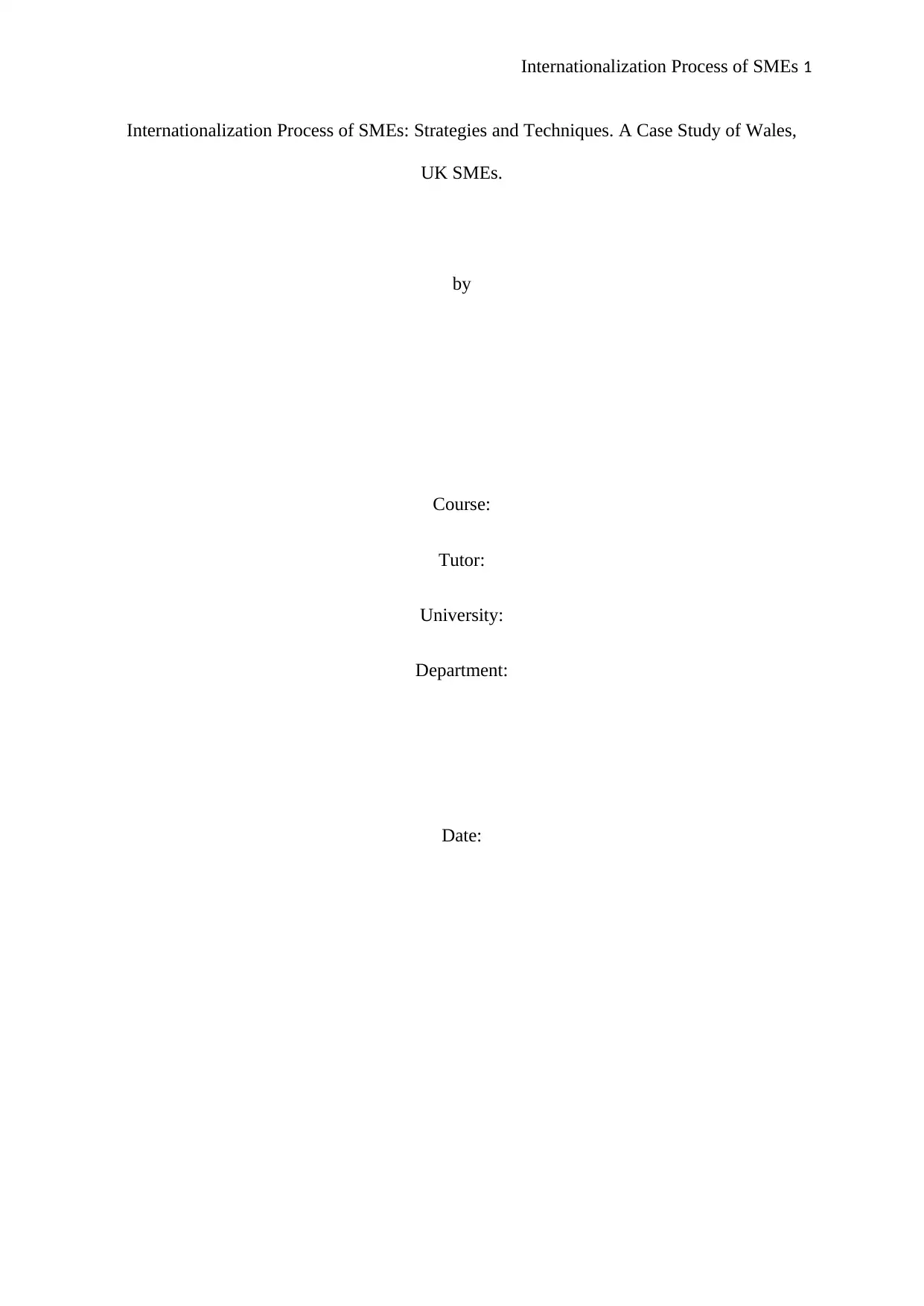
Internationalization Process of SMEs 1
Internationalization Process of SMEs: Strategies and Techniques. A Case Study of Wales,
UK SMEs.
by
Course:
Tutor:
University:
Department:
Date:
Internationalization Process of SMEs: Strategies and Techniques. A Case Study of Wales,
UK SMEs.
by
Course:
Tutor:
University:
Department:
Date:
Paraphrase This Document
Need a fresh take? Get an instant paraphrase of this document with our AI Paraphraser

Internationalization Process of SMEs 2
Table of Contents
Table of Contents.....................................................................................................................2
ABSTRACT..............................................................................................................................2
CHAPTER ONE: INTRODUCTION....................................................................................4
1.1 Background Information..........................................................................................................4
1.2 Research Question.....................................................................................................................5
CHAPTER TWO: LITERATURE ASSESSMENT.............................................................6
2.1 Introduction...............................................................................................................................6
2.2 Theoretical Background............................................................................................................6
2.2.1 Internationalization Theory...............................................................................................6
2.2.2 The Uppsala Internationalization Process Model (U-model)...........................................7
2.2.3 Network Theory..................................................................................................................8
2.3 Internationalization Process and the SME’s............................................................................9
2.4 Entry Modes for International Markets................................................................................10
2.4.1 Exporting...........................................................................................................................11
2.4.2 Turnkey Projects..............................................................................................................11
2.4.3 Licensing............................................................................................................................12
2.4.4 Franchising........................................................................................................................12
2.4.5 Joint Ventures...................................................................................................................13
CHAPTER THREE: PROPOSED RESEARCH METHODOLOGY..............................13
3.1 Introduction.............................................................................................................................13
3.2 Research design........................................................................................................................13
3.3 Study Population......................................................................................................................14
3.4 Data Collection.........................................................................................................................14
3.5 Proposed Data Analysis...........................................................................................................15
3.6 Ethical Issues............................................................................................................................15
3.7 Study Limitations....................................................................................................................15
3.8 Proposed Work Plan................................................................................................................15
References...............................................................................................................................17
ABSTRACT
The current advancements in technology, elimination of trade barriers among others have
influenced the need for rapid globalization allowing effective internationalization of the
Table of Contents
Table of Contents.....................................................................................................................2
ABSTRACT..............................................................................................................................2
CHAPTER ONE: INTRODUCTION....................................................................................4
1.1 Background Information..........................................................................................................4
1.2 Research Question.....................................................................................................................5
CHAPTER TWO: LITERATURE ASSESSMENT.............................................................6
2.1 Introduction...............................................................................................................................6
2.2 Theoretical Background............................................................................................................6
2.2.1 Internationalization Theory...............................................................................................6
2.2.2 The Uppsala Internationalization Process Model (U-model)...........................................7
2.2.3 Network Theory..................................................................................................................8
2.3 Internationalization Process and the SME’s............................................................................9
2.4 Entry Modes for International Markets................................................................................10
2.4.1 Exporting...........................................................................................................................11
2.4.2 Turnkey Projects..............................................................................................................11
2.4.3 Licensing............................................................................................................................12
2.4.4 Franchising........................................................................................................................12
2.4.5 Joint Ventures...................................................................................................................13
CHAPTER THREE: PROPOSED RESEARCH METHODOLOGY..............................13
3.1 Introduction.............................................................................................................................13
3.2 Research design........................................................................................................................13
3.3 Study Population......................................................................................................................14
3.4 Data Collection.........................................................................................................................14
3.5 Proposed Data Analysis...........................................................................................................15
3.6 Ethical Issues............................................................................................................................15
3.7 Study Limitations....................................................................................................................15
3.8 Proposed Work Plan................................................................................................................15
References...............................................................................................................................17
ABSTRACT
The current advancements in technology, elimination of trade barriers among others have
influenced the need for rapid globalization allowing effective internationalization of the
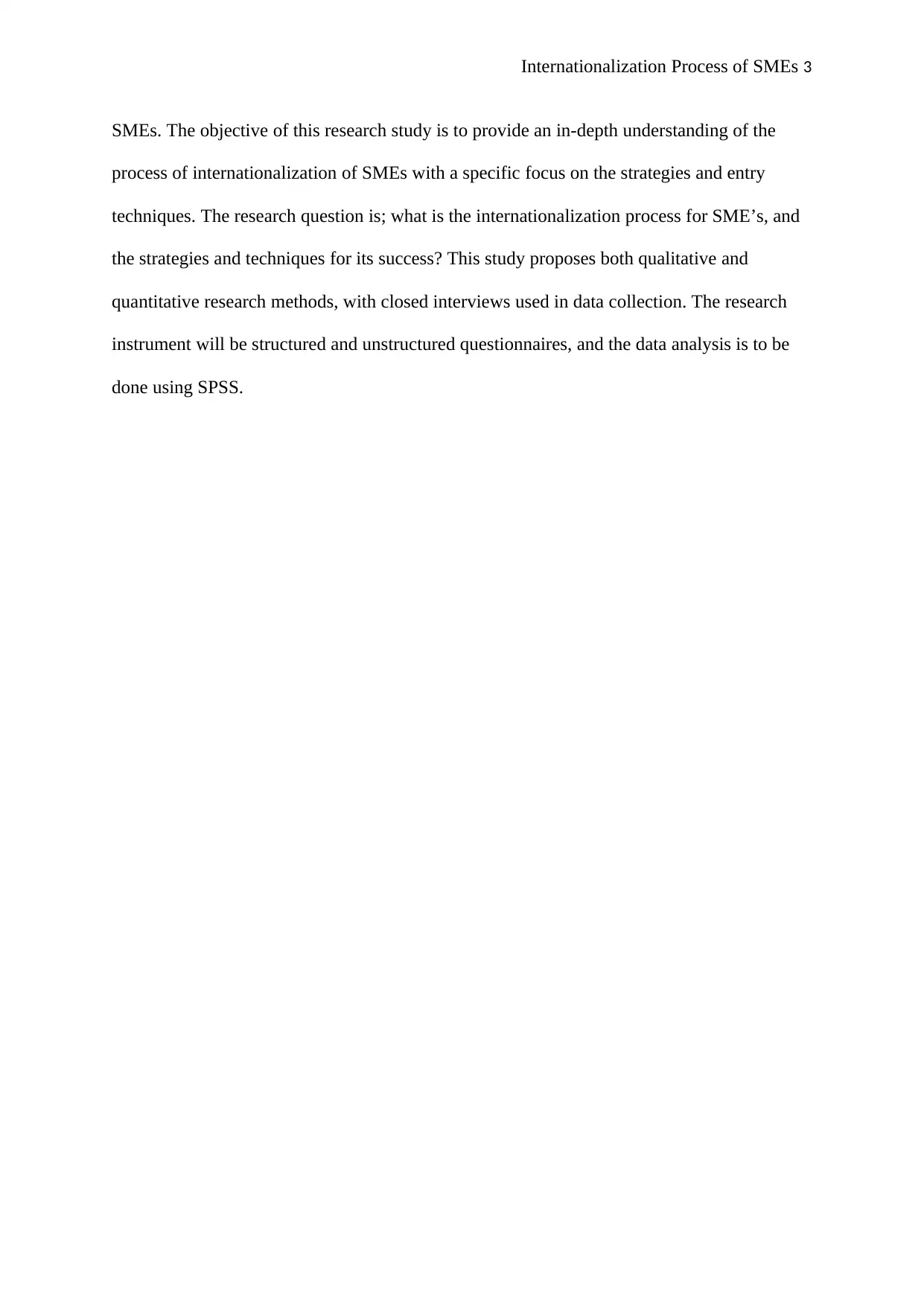
Internationalization Process of SMEs 3
SMEs. The objective of this research study is to provide an in-depth understanding of the
process of internationalization of SMEs with a specific focus on the strategies and entry
techniques. The research question is; what is the internationalization process for SME’s, and
the strategies and techniques for its success? This study proposes both qualitative and
quantitative research methods, with closed interviews used in data collection. The research
instrument will be structured and unstructured questionnaires, and the data analysis is to be
done using SPSS.
SMEs. The objective of this research study is to provide an in-depth understanding of the
process of internationalization of SMEs with a specific focus on the strategies and entry
techniques. The research question is; what is the internationalization process for SME’s, and
the strategies and techniques for its success? This study proposes both qualitative and
quantitative research methods, with closed interviews used in data collection. The research
instrument will be structured and unstructured questionnaires, and the data analysis is to be
done using SPSS.
⊘ This is a preview!⊘
Do you want full access?
Subscribe today to unlock all pages.

Trusted by 1+ million students worldwide

Internationalization Process of SMEs 4
CHAPTER ONE: INTRODUCTION
1.1 Background Information.
Globalization of international economies through trade and investment among other factors
have been the trend in the dynamic business market in the recent years (Cavusgil, and Knight,
2015). The success of businesses in foreign countries necessitates the use of different
strategies and techniques by the leadership (Maurin and Yeophantong, 2013). Much attention
has been given to internationalization process regarding the active role of small and medium
enterprises (SMEs) in the international markets. The most explored theories and models in
the field of internationalization include The Uppsala Internationalization Process Model,
Network Theory, and International Entrepreneurship Theory among others (Schulz, Borghoff,
and Kraus, 2009). The stage model was used some decades back, and it comprises of a
process where corporations begin from local markets and gradually rise to the international
market and at last owns subsidiaries in foreign nations. This is the nature of the Uppsala
model by Vahlne and Johanson (2017). The Network Approach was later introduced by
Johanson and Mattsson (2015), in which the authors emphasized the significance of
relationships with suppliers, clients, and market that can assist a company to go global.
The advancement of technology, reduced trade barriers, etc. are supporting the integration of
the global economy and as a result, this fast globalization enabling SMEs to go worldwide at
a speedy and effective rate (Dunning, 2014). This has prompted in-depth research and
criticism of the existing theories on internationalization processes and strategies. The
internationalization process is beset with risks and uncertainties which substantially affect the
organization’s strategy. Strategy formulation is a significant process which precedes
internationalization process, and it’s about deciding on the type of market, time and the entry
mode (Vahlne and Johanson, 2017). Successful internationalization requires businesses to
minimize risks and uncertainties, and this can be achieved through the choice of the right
CHAPTER ONE: INTRODUCTION
1.1 Background Information.
Globalization of international economies through trade and investment among other factors
have been the trend in the dynamic business market in the recent years (Cavusgil, and Knight,
2015). The success of businesses in foreign countries necessitates the use of different
strategies and techniques by the leadership (Maurin and Yeophantong, 2013). Much attention
has been given to internationalization process regarding the active role of small and medium
enterprises (SMEs) in the international markets. The most explored theories and models in
the field of internationalization include The Uppsala Internationalization Process Model,
Network Theory, and International Entrepreneurship Theory among others (Schulz, Borghoff,
and Kraus, 2009). The stage model was used some decades back, and it comprises of a
process where corporations begin from local markets and gradually rise to the international
market and at last owns subsidiaries in foreign nations. This is the nature of the Uppsala
model by Vahlne and Johanson (2017). The Network Approach was later introduced by
Johanson and Mattsson (2015), in which the authors emphasized the significance of
relationships with suppliers, clients, and market that can assist a company to go global.
The advancement of technology, reduced trade barriers, etc. are supporting the integration of
the global economy and as a result, this fast globalization enabling SMEs to go worldwide at
a speedy and effective rate (Dunning, 2014). This has prompted in-depth research and
criticism of the existing theories on internationalization processes and strategies. The
internationalization process is beset with risks and uncertainties which substantially affect the
organization’s strategy. Strategy formulation is a significant process which precedes
internationalization process, and it’s about deciding on the type of market, time and the entry
mode (Vahlne and Johanson, 2017). Successful internationalization requires businesses to
minimize risks and uncertainties, and this can be achieved through the choice of the right
Paraphrase This Document
Need a fresh take? Get an instant paraphrase of this document with our AI Paraphraser
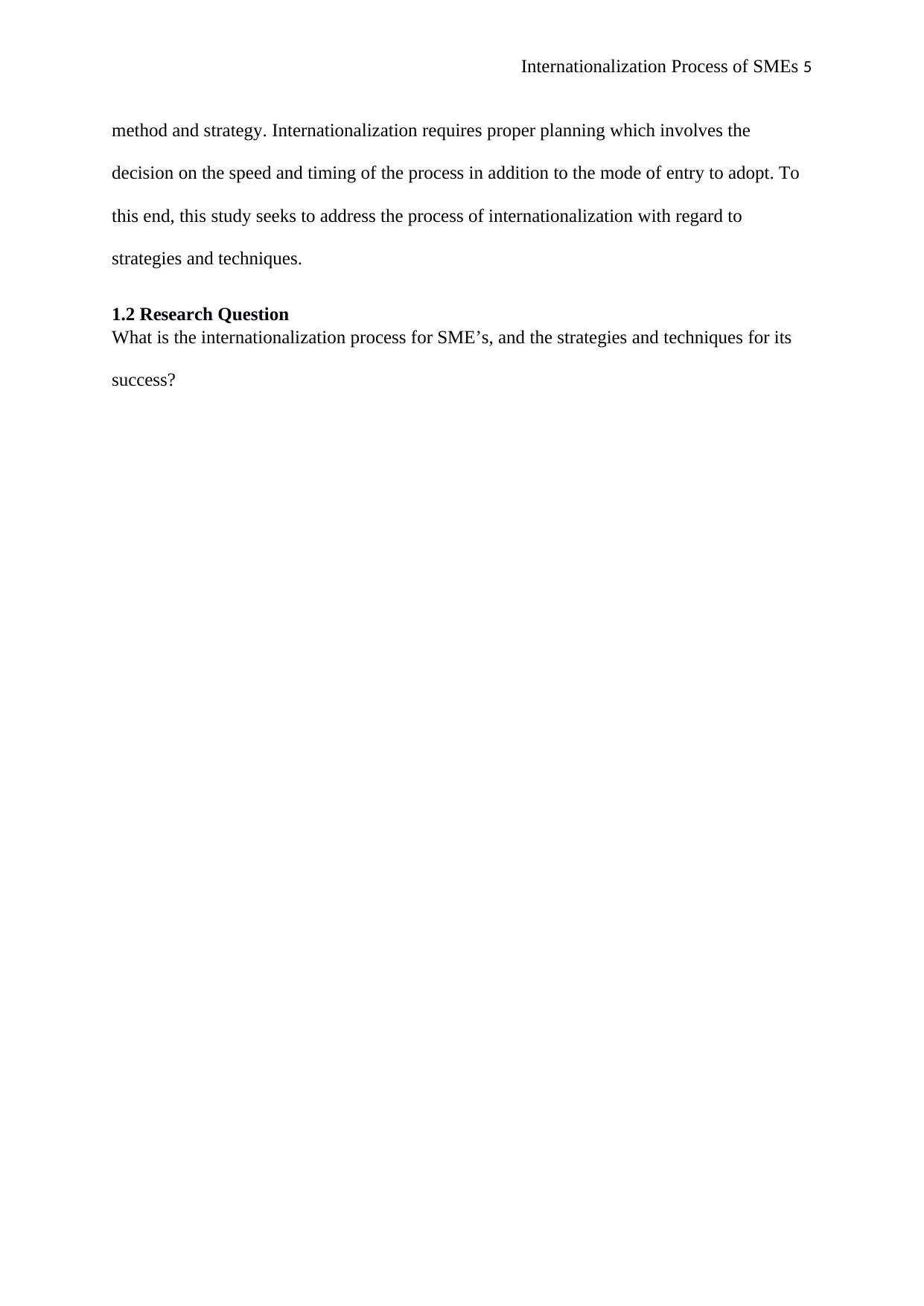
Internationalization Process of SMEs 5
method and strategy. Internationalization requires proper planning which involves the
decision on the speed and timing of the process in addition to the mode of entry to adopt. To
this end, this study seeks to address the process of internationalization with regard to
strategies and techniques.
1.2 Research Question
What is the internationalization process for SME’s, and the strategies and techniques for its
success?
method and strategy. Internationalization requires proper planning which involves the
decision on the speed and timing of the process in addition to the mode of entry to adopt. To
this end, this study seeks to address the process of internationalization with regard to
strategies and techniques.
1.2 Research Question
What is the internationalization process for SME’s, and the strategies and techniques for its
success?

Internationalization Process of SMEs 6
CHAPTER TWO: LITERATURE ASSESSMENT
2.1 Introduction
This chapter outlines the literature on the internationalization of business activities by SMEs.
The section also includes a review of literature undertaken by other researchers, relevant to
the topic under study. These include the theoretical background, Internationalization Process
and the SME’s, entry Modes for International Markets, empirical Literature, and
2.2 Theoretical Background
2.2.1 Internationalization Theory
Internationalization theory proposes that it is more profitable for production companies to
exist singly in given locations. The first approach to exploring the benefits of
internationalization in firms is to highlight the significance of technology transfer (Pedersen
and Shaver, 2011). Brennan and Garvey (2009) posit that there is complexity on the buyer
when appraising the real value of knowledge. Additionally, it is not possible to quantify
knowledge in monetary terms and sell it, and also it is challenging to secure intellectual
property rights. As a result, it is more profitable for businesses to start a new enterprise in the
international market than to sell technology to another enterprise (Lee et al., 2012).
The focus of the second method is on vertical integration which implies an apparent dispute
between firms. Furthermore, coordination issues may arise due to the imbalances in demand
and supply between two enterprises. Unstable prices pose substantial risks for both
organizations (Pedersen and Shaver, 2011). Hence, this model posits that the critical issue in
internationalization is lack of knowledge concerning markets which are associated with the
costs, clients and the alternatives regarded by the decision makers.
Experiential knowledge reduces the risks encountered in expanding to the foreign market and
also acts as a mechanism for attaining internal and external knowledge and of the chance of
combining both (Brennan and Garvey, 2009). On the other hand, Sandberg (2013) notes that
CHAPTER TWO: LITERATURE ASSESSMENT
2.1 Introduction
This chapter outlines the literature on the internationalization of business activities by SMEs.
The section also includes a review of literature undertaken by other researchers, relevant to
the topic under study. These include the theoretical background, Internationalization Process
and the SME’s, entry Modes for International Markets, empirical Literature, and
2.2 Theoretical Background
2.2.1 Internationalization Theory
Internationalization theory proposes that it is more profitable for production companies to
exist singly in given locations. The first approach to exploring the benefits of
internationalization in firms is to highlight the significance of technology transfer (Pedersen
and Shaver, 2011). Brennan and Garvey (2009) posit that there is complexity on the buyer
when appraising the real value of knowledge. Additionally, it is not possible to quantify
knowledge in monetary terms and sell it, and also it is challenging to secure intellectual
property rights. As a result, it is more profitable for businesses to start a new enterprise in the
international market than to sell technology to another enterprise (Lee et al., 2012).
The focus of the second method is on vertical integration which implies an apparent dispute
between firms. Furthermore, coordination issues may arise due to the imbalances in demand
and supply between two enterprises. Unstable prices pose substantial risks for both
organizations (Pedersen and Shaver, 2011). Hence, this model posits that the critical issue in
internationalization is lack of knowledge concerning markets which are associated with the
costs, clients and the alternatives regarded by the decision makers.
Experiential knowledge reduces the risks encountered in expanding to the foreign market and
also acts as a mechanism for attaining internal and external knowledge and of the chance of
combining both (Brennan and Garvey, 2009). On the other hand, Sandberg (2013) notes that
⊘ This is a preview!⊘
Do you want full access?
Subscribe today to unlock all pages.

Trusted by 1+ million students worldwide
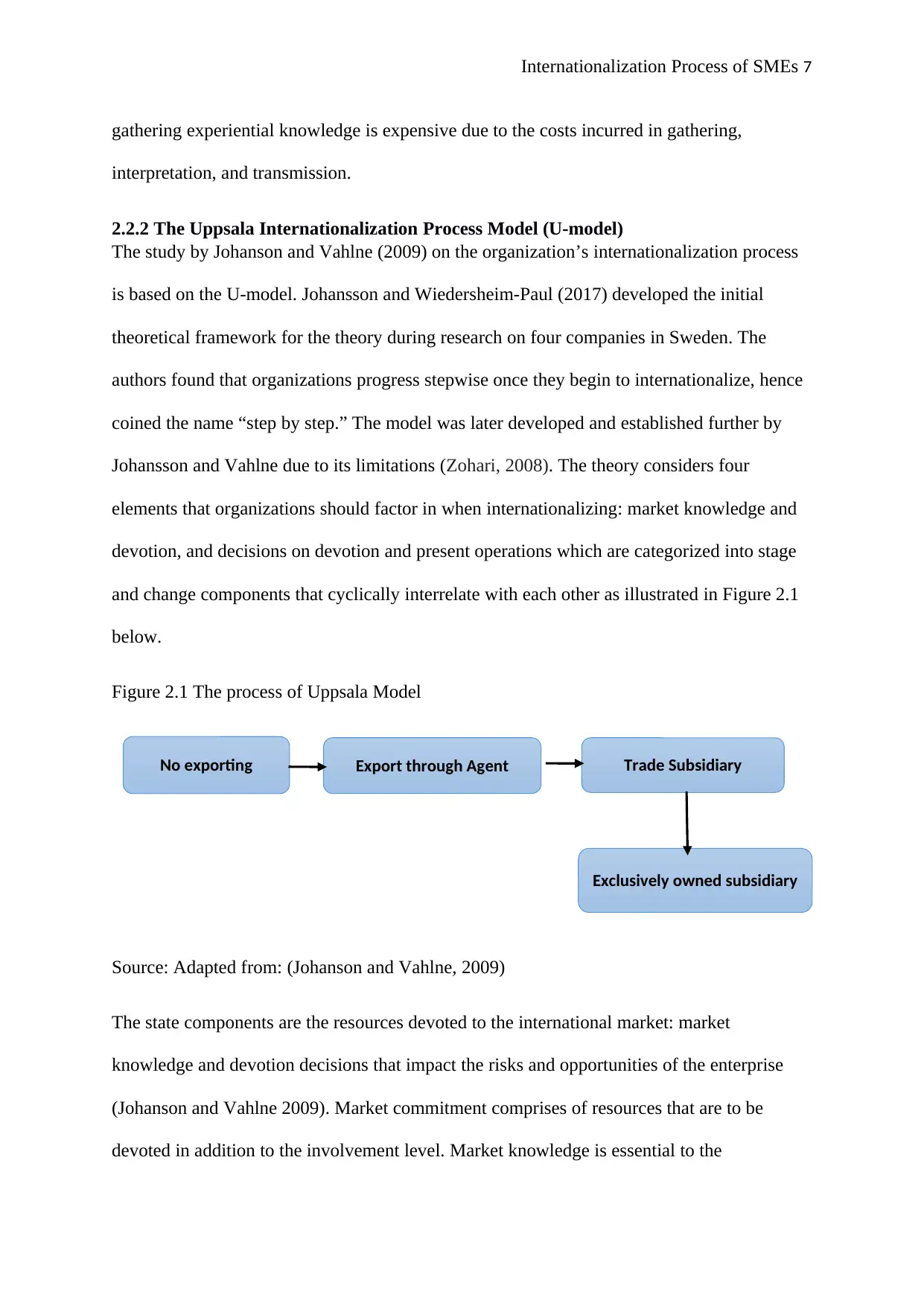
Internationalization Process of SMEs 7
gathering experiential knowledge is expensive due to the costs incurred in gathering,
interpretation, and transmission.
2.2.2 The Uppsala Internationalization Process Model (U-model)
The study by Johanson and Vahlne (2009) on the organization’s internationalization process
is based on the U-model. Johansson and Wiedersheim-Paul (2017) developed the initial
theoretical framework for the theory during research on four companies in Sweden. The
authors found that organizations progress stepwise once they begin to internationalize, hence
coined the name “step by step.” The model was later developed and established further by
Johansson and Vahlne due to its limitations (Zohari, 2008). The theory considers four
elements that organizations should factor in when internationalizing: market knowledge and
devotion, and decisions on devotion and present operations which are categorized into stage
and change components that cyclically interrelate with each other as illustrated in Figure 2.1
below.
Figure 2.1 The process of Uppsala Model
Source: Adapted from: (Johanson and Vahlne, 2009)
The state components are the resources devoted to the international market: market
knowledge and devotion decisions that impact the risks and opportunities of the enterprise
(Johanson and Vahlne 2009). Market commitment comprises of resources that are to be
devoted in addition to the involvement level. Market knowledge is essential to the
No exporting Export through Agent Trade Subsidiary
Exclusively owned subsidiary
gathering experiential knowledge is expensive due to the costs incurred in gathering,
interpretation, and transmission.
2.2.2 The Uppsala Internationalization Process Model (U-model)
The study by Johanson and Vahlne (2009) on the organization’s internationalization process
is based on the U-model. Johansson and Wiedersheim-Paul (2017) developed the initial
theoretical framework for the theory during research on four companies in Sweden. The
authors found that organizations progress stepwise once they begin to internationalize, hence
coined the name “step by step.” The model was later developed and established further by
Johansson and Vahlne due to its limitations (Zohari, 2008). The theory considers four
elements that organizations should factor in when internationalizing: market knowledge and
devotion, and decisions on devotion and present operations which are categorized into stage
and change components that cyclically interrelate with each other as illustrated in Figure 2.1
below.
Figure 2.1 The process of Uppsala Model
Source: Adapted from: (Johanson and Vahlne, 2009)
The state components are the resources devoted to the international market: market
knowledge and devotion decisions that impact the risks and opportunities of the enterprise
(Johanson and Vahlne 2009). Market commitment comprises of resources that are to be
devoted in addition to the involvement level. Market knowledge is essential to the
No exporting Export through Agent Trade Subsidiary
Exclusively owned subsidiary
Paraphrase This Document
Need a fresh take? Get an instant paraphrase of this document with our AI Paraphraser

Internationalization Process of SMEs 8
management in decision making. The two forms of knowledge are the experiential
knowledge, which is acquired through experience, and objective knowledge, which is
transferred between markets. Change elements are outcomes of the state elements. After
learning about the market, the management can determine the approach it will take to devote
itself to it, and thus enable them to strategize and implement the present operations that are
required to complete the cycle. Hermannsdottir, (2008) demonstrates that this model
fundamentally assumes that decisions on devotion are affected by market knowledge and
market devotion.
2.2.3 Network Theory
This model contends that the current advanced technology companies do not follow the step
by step process; but instead attain rapid internationalization through experience and network
partners’ resources (Johanson and Mattsson, 2015). The entire group of organizations in the
market are assumed to be rooted in one or more networks through connections to their
providers, subcontractors, clients and other players in the market (Johanson and Mattsson,
2015). Forsgren (2015) defines a network as a combination of two or more linked firms’
inter-associations, in which each operational exchange association is amongst enterprises that
are theorized as collective performers. Thus, networks are a connecting approach that permits
quick internationalization. Ojala (2009) found out that network relationships rely on common
trust, knowledge, and devotion to each other.
Johanson & Mattsson (2015) observes that businesses occupy and develop a particular market
position in reference to other players in the foreign network. Organizations that expand to
global markets get involved in a domestic network to establish and grow business
relationship abroad objectively. According to Lindblom (2010), market coordination is as a
result of the interaction of the organizations engaged in the network, where decision making
is influenced by many aspects such as price.
management in decision making. The two forms of knowledge are the experiential
knowledge, which is acquired through experience, and objective knowledge, which is
transferred between markets. Change elements are outcomes of the state elements. After
learning about the market, the management can determine the approach it will take to devote
itself to it, and thus enable them to strategize and implement the present operations that are
required to complete the cycle. Hermannsdottir, (2008) demonstrates that this model
fundamentally assumes that decisions on devotion are affected by market knowledge and
market devotion.
2.2.3 Network Theory
This model contends that the current advanced technology companies do not follow the step
by step process; but instead attain rapid internationalization through experience and network
partners’ resources (Johanson and Mattsson, 2015). The entire group of organizations in the
market are assumed to be rooted in one or more networks through connections to their
providers, subcontractors, clients and other players in the market (Johanson and Mattsson,
2015). Forsgren (2015) defines a network as a combination of two or more linked firms’
inter-associations, in which each operational exchange association is amongst enterprises that
are theorized as collective performers. Thus, networks are a connecting approach that permits
quick internationalization. Ojala (2009) found out that network relationships rely on common
trust, knowledge, and devotion to each other.
Johanson & Mattsson (2015) observes that businesses occupy and develop a particular market
position in reference to other players in the foreign network. Organizations that expand to
global markets get involved in a domestic network to establish and grow business
relationship abroad objectively. According to Lindblom (2010), market coordination is as a
result of the interaction of the organizations engaged in the network, where decision making
is influenced by many aspects such as price.
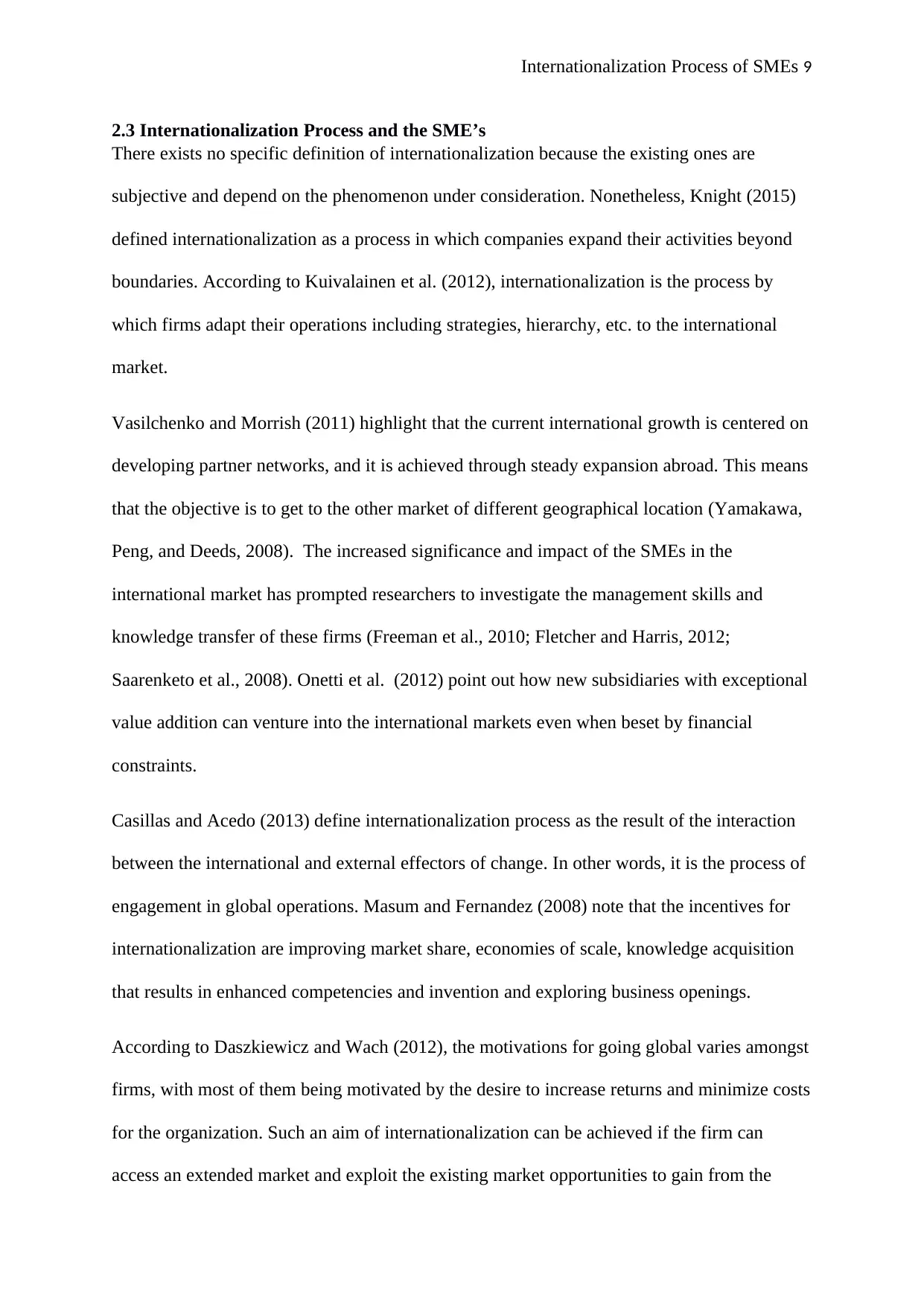
Internationalization Process of SMEs 9
2.3 Internationalization Process and the SME’s
There exists no specific definition of internationalization because the existing ones are
subjective and depend on the phenomenon under consideration. Nonetheless, Knight (2015)
defined internationalization as a process in which companies expand their activities beyond
boundaries. According to Kuivalainen et al. (2012), internationalization is the process by
which firms adapt their operations including strategies, hierarchy, etc. to the international
market.
Vasilchenko and Morrish (2011) highlight that the current international growth is centered on
developing partner networks, and it is achieved through steady expansion abroad. This means
that the objective is to get to the other market of different geographical location (Yamakawa,
Peng, and Deeds, 2008). The increased significance and impact of the SMEs in the
international market has prompted researchers to investigate the management skills and
knowledge transfer of these firms (Freeman et al., 2010; Fletcher and Harris, 2012;
Saarenketo et al., 2008). Onetti et al. (2012) point out how new subsidiaries with exceptional
value addition can venture into the international markets even when beset by financial
constraints.
Casillas and Acedo (2013) define internationalization process as the result of the interaction
between the international and external effectors of change. In other words, it is the process of
engagement in global operations. Masum and Fernandez (2008) note that the incentives for
internationalization are improving market share, economies of scale, knowledge acquisition
that results in enhanced competencies and invention and exploring business openings.
According to Daszkiewicz and Wach (2012), the motivations for going global varies amongst
firms, with most of them being motivated by the desire to increase returns and minimize costs
for the organization. Such an aim of internationalization can be achieved if the firm can
access an extended market and exploit the existing market opportunities to gain from the
2.3 Internationalization Process and the SME’s
There exists no specific definition of internationalization because the existing ones are
subjective and depend on the phenomenon under consideration. Nonetheless, Knight (2015)
defined internationalization as a process in which companies expand their activities beyond
boundaries. According to Kuivalainen et al. (2012), internationalization is the process by
which firms adapt their operations including strategies, hierarchy, etc. to the international
market.
Vasilchenko and Morrish (2011) highlight that the current international growth is centered on
developing partner networks, and it is achieved through steady expansion abroad. This means
that the objective is to get to the other market of different geographical location (Yamakawa,
Peng, and Deeds, 2008). The increased significance and impact of the SMEs in the
international market has prompted researchers to investigate the management skills and
knowledge transfer of these firms (Freeman et al., 2010; Fletcher and Harris, 2012;
Saarenketo et al., 2008). Onetti et al. (2012) point out how new subsidiaries with exceptional
value addition can venture into the international markets even when beset by financial
constraints.
Casillas and Acedo (2013) define internationalization process as the result of the interaction
between the international and external effectors of change. In other words, it is the process of
engagement in global operations. Masum and Fernandez (2008) note that the incentives for
internationalization are improving market share, economies of scale, knowledge acquisition
that results in enhanced competencies and invention and exploring business openings.
According to Daszkiewicz and Wach (2012), the motivations for going global varies amongst
firms, with most of them being motivated by the desire to increase returns and minimize costs
for the organization. Such an aim of internationalization can be achieved if the firm can
access an extended market and exploit the existing market opportunities to gain from the
⊘ This is a preview!⊘
Do you want full access?
Subscribe today to unlock all pages.

Trusted by 1+ million students worldwide

Internationalization Process of SMEs 10
large-scale production and economies of scale (Javalgi and Todd, 2011). The economies will
enable the enterprise to minimize costs and increase returns (Sauvant, 2009). Irrespective of
constrained resources, small businesses adopt a combination of strategies to attain success in
different global markets (Knight, 2015). There is a similarity in the internationalization
process of these companies which in one way or the other adheres to a systematic process of
improved performance on the local market and then undertakes the market in the nearest
boundary (Daszkiewicz and Wach, 2012). Likewise, the difficulties these enterprises undergo
during internationalization process are identical. Al-Hyari (2012) ascertained that most of the
entities are unwilling to offer loans to some these companies for fear of uncertainty in the
operations that the firm is involved in whether they will be profitable.
2.4 Entry Modes for International Markets
According to Golo (2015), the management has to consider three fundamental factors before
going international; the market to venture in, the timing of entry, and the scale. Golo reasons
that an entity should venture into the market that is more lucrative to it through striking an
equilibrium between returns, costs, and uncertainties. Similar conclusions are derived by
Canabal and White III (2008) in their research on the past and future market entry modes.
Golo (2015) further observes that the time of entry can either be first-movers or future-
entrants. The first-movers are the companies that enter the global market before any other
business in the same sector does. They become the pioneers in the market but at a high cost.
The future entrants are the companies that venture the international market after the first
movers have entered. The future entrants have the advantage of low risk and fewer costs
since they imitate the first movers. Regarding the scale, an organization can decide to venture
on a small or large scale depending on the level of devotion. Entry into a large scale means
the firm will incur substantial resources but with faster entry, whereas a small scale entry
enables the company to study the selected market but with low exposure to it (Golo, 2015).
large-scale production and economies of scale (Javalgi and Todd, 2011). The economies will
enable the enterprise to minimize costs and increase returns (Sauvant, 2009). Irrespective of
constrained resources, small businesses adopt a combination of strategies to attain success in
different global markets (Knight, 2015). There is a similarity in the internationalization
process of these companies which in one way or the other adheres to a systematic process of
improved performance on the local market and then undertakes the market in the nearest
boundary (Daszkiewicz and Wach, 2012). Likewise, the difficulties these enterprises undergo
during internationalization process are identical. Al-Hyari (2012) ascertained that most of the
entities are unwilling to offer loans to some these companies for fear of uncertainty in the
operations that the firm is involved in whether they will be profitable.
2.4 Entry Modes for International Markets
According to Golo (2015), the management has to consider three fundamental factors before
going international; the market to venture in, the timing of entry, and the scale. Golo reasons
that an entity should venture into the market that is more lucrative to it through striking an
equilibrium between returns, costs, and uncertainties. Similar conclusions are derived by
Canabal and White III (2008) in their research on the past and future market entry modes.
Golo (2015) further observes that the time of entry can either be first-movers or future-
entrants. The first-movers are the companies that enter the global market before any other
business in the same sector does. They become the pioneers in the market but at a high cost.
The future entrants are the companies that venture the international market after the first
movers have entered. The future entrants have the advantage of low risk and fewer costs
since they imitate the first movers. Regarding the scale, an organization can decide to venture
on a small or large scale depending on the level of devotion. Entry into a large scale means
the firm will incur substantial resources but with faster entry, whereas a small scale entry
enables the company to study the selected market but with low exposure to it (Golo, 2015).
Paraphrase This Document
Need a fresh take? Get an instant paraphrase of this document with our AI Paraphraser

Internationalization Process of SMEs 11
2.4.1 Exporting
Phillips and Ahmadi‐Esfahani (2008) observe that exporting has for decades been considered
as the initial step towards going global, acting as a basis for future global market expansions.
Exportation is the most common strategy adopted by SMEs due to limited resources (Love
and Roper, 2015), and some level of market knowledge and experience (Meyer et al., 2009).
According to Hill (2008), this entry technique is beneficial for it avoids the manufacturing
costs in the host country. It can also be a drawback if the production costs in the host country
are cheaper. Filatotchev et al. (2009) found out that exporting technique increased the scale
economy of firms in their international sales volume if the production was carried out in the
home country and exported to foreign markets. Love & Roper (2015) asserts that exportation
is a significant way for SMEs to obtain additional market knowledge and experience from the
host market. Nguyen et al. (2008) point out that exporting is a risky venture for SMEs
especially if the host country has stringent legislation on consumer protection like tariff
barrier.
2.4.2 Turnkey Projects
These are projects in which two companies are tasked with the responsibility of a given plant
or machine such as oil plants (Vassileva and Nikolov, 2016). Hill (2008) observes that
turnkey projects are common in industries like chemical and pharmaceutical and construction
sectors. One of the company may have the resources required for a product but without the
technology needed for production, hence involves another qualified firm. The contractor
provides training to the client’s operative employees until the plant can fully be operated by
the host. This entry mode is of importance in situations where there is the limitation of
foreign direct investment (FDI) by the government of the host market. Masum and Fernandez
(2008) show that a turnkey project entry technique offers great economic assets due the
know-how gains because they are assets of value for the entities; also, after the end of the
project, there are no long-term interests of the contractor in the foreign country. Hill (2008)
2.4.1 Exporting
Phillips and Ahmadi‐Esfahani (2008) observe that exporting has for decades been considered
as the initial step towards going global, acting as a basis for future global market expansions.
Exportation is the most common strategy adopted by SMEs due to limited resources (Love
and Roper, 2015), and some level of market knowledge and experience (Meyer et al., 2009).
According to Hill (2008), this entry technique is beneficial for it avoids the manufacturing
costs in the host country. It can also be a drawback if the production costs in the host country
are cheaper. Filatotchev et al. (2009) found out that exporting technique increased the scale
economy of firms in their international sales volume if the production was carried out in the
home country and exported to foreign markets. Love & Roper (2015) asserts that exportation
is a significant way for SMEs to obtain additional market knowledge and experience from the
host market. Nguyen et al. (2008) point out that exporting is a risky venture for SMEs
especially if the host country has stringent legislation on consumer protection like tariff
barrier.
2.4.2 Turnkey Projects
These are projects in which two companies are tasked with the responsibility of a given plant
or machine such as oil plants (Vassileva and Nikolov, 2016). Hill (2008) observes that
turnkey projects are common in industries like chemical and pharmaceutical and construction
sectors. One of the company may have the resources required for a product but without the
technology needed for production, hence involves another qualified firm. The contractor
provides training to the client’s operative employees until the plant can fully be operated by
the host. This entry mode is of importance in situations where there is the limitation of
foreign direct investment (FDI) by the government of the host market. Masum and Fernandez
(2008) show that a turnkey project entry technique offers great economic assets due the
know-how gains because they are assets of value for the entities; also, after the end of the
project, there are no long-term interests of the contractor in the foreign country. Hill (2008)
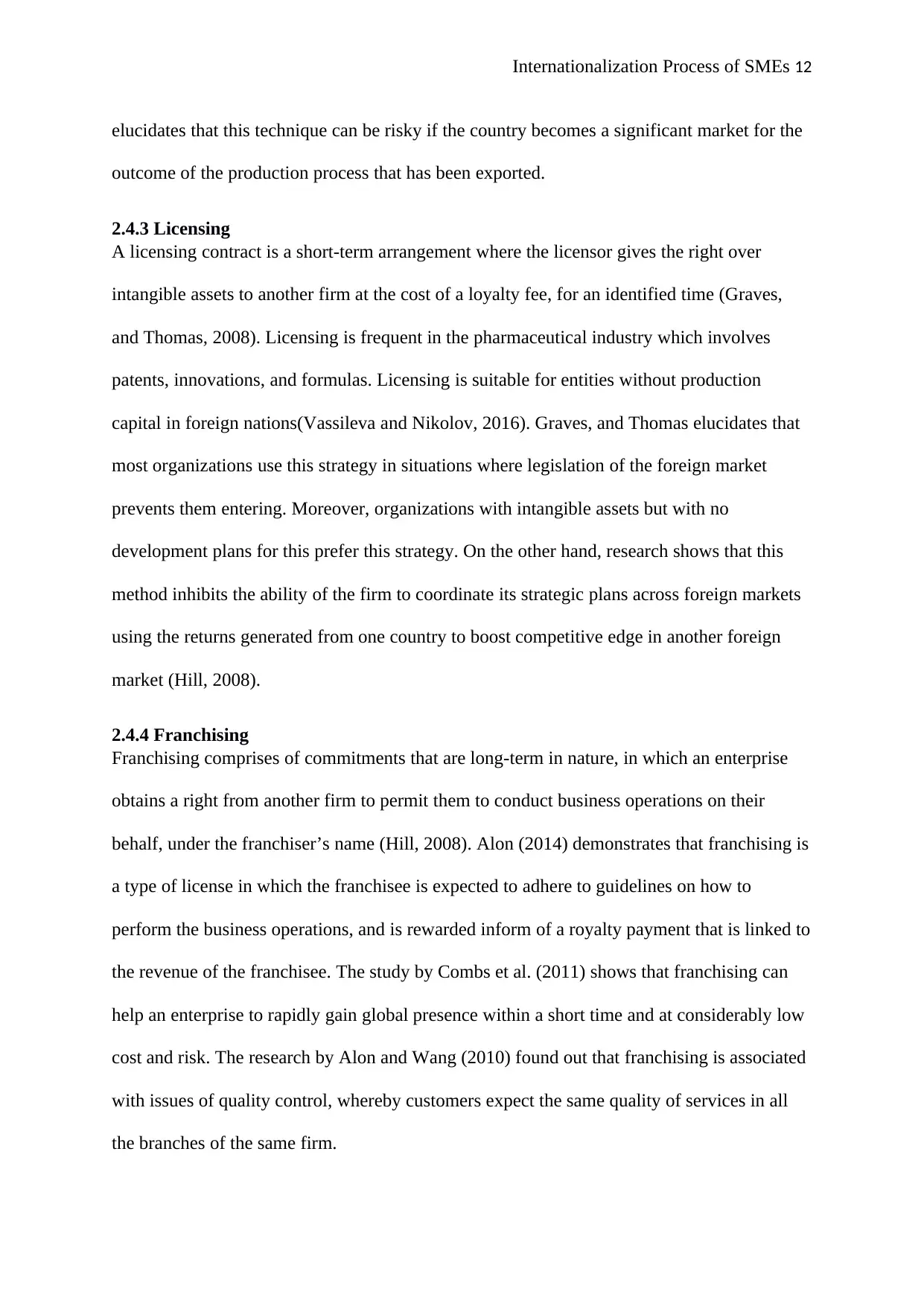
Internationalization Process of SMEs 12
elucidates that this technique can be risky if the country becomes a significant market for the
outcome of the production process that has been exported.
2.4.3 Licensing
A licensing contract is a short-term arrangement where the licensor gives the right over
intangible assets to another firm at the cost of a loyalty fee, for an identified time (Graves,
and Thomas, 2008). Licensing is frequent in the pharmaceutical industry which involves
patents, innovations, and formulas. Licensing is suitable for entities without production
capital in foreign nations(Vassileva and Nikolov, 2016). Graves, and Thomas elucidates that
most organizations use this strategy in situations where legislation of the foreign market
prevents them entering. Moreover, organizations with intangible assets but with no
development plans for this prefer this strategy. On the other hand, research shows that this
method inhibits the ability of the firm to coordinate its strategic plans across foreign markets
using the returns generated from one country to boost competitive edge in another foreign
market (Hill, 2008).
2.4.4 Franchising
Franchising comprises of commitments that are long-term in nature, in which an enterprise
obtains a right from another firm to permit them to conduct business operations on their
behalf, under the franchiser’s name (Hill, 2008). Alon (2014) demonstrates that franchising is
a type of license in which the franchisee is expected to adhere to guidelines on how to
perform the business operations, and is rewarded inform of a royalty payment that is linked to
the revenue of the franchisee. The study by Combs et al. (2011) shows that franchising can
help an enterprise to rapidly gain global presence within a short time and at considerably low
cost and risk. The research by Alon and Wang (2010) found out that franchising is associated
with issues of quality control, whereby customers expect the same quality of services in all
the branches of the same firm.
elucidates that this technique can be risky if the country becomes a significant market for the
outcome of the production process that has been exported.
2.4.3 Licensing
A licensing contract is a short-term arrangement where the licensor gives the right over
intangible assets to another firm at the cost of a loyalty fee, for an identified time (Graves,
and Thomas, 2008). Licensing is frequent in the pharmaceutical industry which involves
patents, innovations, and formulas. Licensing is suitable for entities without production
capital in foreign nations(Vassileva and Nikolov, 2016). Graves, and Thomas elucidates that
most organizations use this strategy in situations where legislation of the foreign market
prevents them entering. Moreover, organizations with intangible assets but with no
development plans for this prefer this strategy. On the other hand, research shows that this
method inhibits the ability of the firm to coordinate its strategic plans across foreign markets
using the returns generated from one country to boost competitive edge in another foreign
market (Hill, 2008).
2.4.4 Franchising
Franchising comprises of commitments that are long-term in nature, in which an enterprise
obtains a right from another firm to permit them to conduct business operations on their
behalf, under the franchiser’s name (Hill, 2008). Alon (2014) demonstrates that franchising is
a type of license in which the franchisee is expected to adhere to guidelines on how to
perform the business operations, and is rewarded inform of a royalty payment that is linked to
the revenue of the franchisee. The study by Combs et al. (2011) shows that franchising can
help an enterprise to rapidly gain global presence within a short time and at considerably low
cost and risk. The research by Alon and Wang (2010) found out that franchising is associated
with issues of quality control, whereby customers expect the same quality of services in all
the branches of the same firm.
⊘ This is a preview!⊘
Do you want full access?
Subscribe today to unlock all pages.

Trusted by 1+ million students worldwide
1 out of 22
Related Documents
Your All-in-One AI-Powered Toolkit for Academic Success.
+13062052269
info@desklib.com
Available 24*7 on WhatsApp / Email
![[object Object]](/_next/static/media/star-bottom.7253800d.svg)
Unlock your academic potential
Copyright © 2020–2025 A2Z Services. All Rights Reserved. Developed and managed by ZUCOL.





